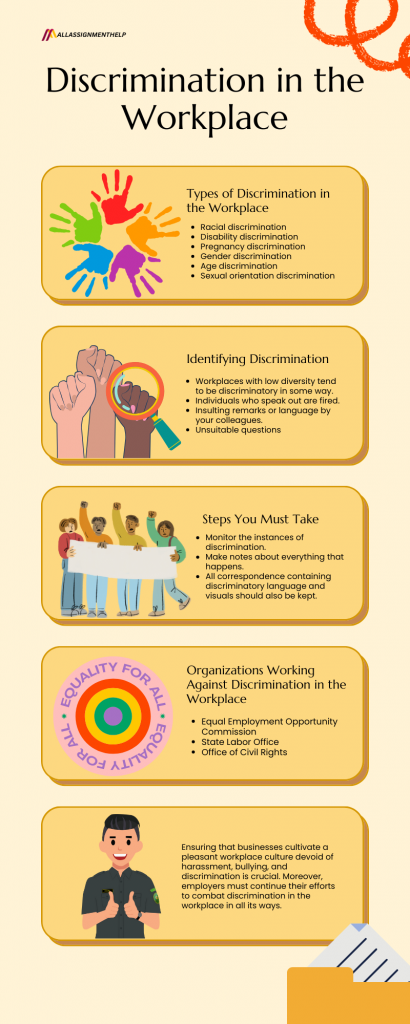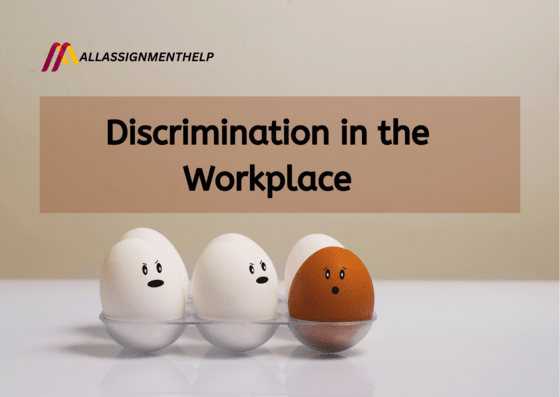Table of Contents
We all are aware of the term discrimination. It is to treat a person differently or less favourably for reasons. Moreover, it can happen anywhere, at school, office, mall, public places, etc. It is a prejudicial practice ingrained in mankind for centuries and it is still not completely abolished. However, some steps are being taken to prevent discrimination in the workplace. The EEOC (Equal Employment Opportunity Commission) is there to protect you from employment discrimination based on sex, race, colour, age, national origin, genetic information, and disability. Any type of unfair treatment, harassment, retaliation, improper questioning, and denial of a reasonable workplace change is taken care of with the laws enforced by EEOC.
This blog, composed by the experts at All Assignment Help talks about various types of discrimination in the workplace, how to identify them, what to do about it, and organizations that work against discrimination.
Types of Discrimination in the Workplace
Let us read about some of the major types of discrimination in the workplace.
Racial discrimination
Racial discrimination is the most common type where every year more than a third of claims are made to EEOC. Moreover, it can come to you as direct actions such as comments on your physical features, colour, racial background, etc. Any race-based commentary falls under racial discrimination in the workplace.
Disability discrimination
This type of discrimination can be unintentional sometimes. For example, people might make some sort of assumption about your disability, that you cannot perform a work in a certain way, unfair policies against you, outright hostility, etc.
Pregnancy discrimination
This type of discrimination can be against new mothers or expecting ones. It includes mistreatment based on various reasons that eventually turn out to be sex discrimination, gender discrimination, retaliation for practising your employee rights, disability discrimination, etc.
Discrimination in the workplace is vast. Hence, as a student, if you are assigned to write an essay or report on it, you will have a lot to learn. Moreover, some students find writing overwhelming. So, in that case, you can seek an online coursework service to assist you with a detailed report with the right facts and evidence. This topic shouldn’t be handled with less care. It is significant.
In addition to this, there are various laws that can help you if you are facing any sort of pregnancy discrimination in the workplace.
- California Family Rights Act
- Americans with Disabilities Act
- California Fair Employment and Housing Act
- Federal Pregnancy Discrimination Act
- Title VII of the Federal Civil Rights Act of 1964
- State and federal wage and hour laws
- Federal Family and Medical Leave Act
Gender discrimination
It is pervasive in the workplace and is defined as when someone is treated differently due to their gender. Instances of gender discrimination in the workplace include not hiring women. Moreover, it takes the form of not providing leadership training, not promoting women, sidelining women after having children, paying less, or punishing women for being aggressive or persistent, qualities that most managers find attractive in their male staff members.
Age discrimination
One of the forms of discrimination in the workplace that is expanding the fastest right now is age discrimination. It is when someone over 40 is treated unfairly. The EEOC receives an increasing number of age discrimination complaints each year as the baby boomer cohort matures and experiences financial instability as they approach retirement.
Sexual orientation discrimination
It should never be acceptable in the workplace for someone to be treated unfairly because of their gender identity or sexual orientation, but this still happens. They are being made to feel unsafe at work, experiencing harassment because of their sexual orientation, and having their managers refuse them promotion simply because of who they are.
Also read: Why Finance Is a Best Career Path in 2023

Identifying Discrimination in the Workplace
It can be difficult to identify discrimination in the workplace. However, you might experience it before you can identify it. Moreover, sometimes it might elapse before you can record and provide evidence of it. It is common to write off hostile behaviour in the workplace as harmless, joking, or unintentional, and in certain situations, this is true. Here are a few mild instances of discrimination in the workplace.
- Workplaces with low diversity tend to be discriminatory in some way.
- Individuals who speak out are fired. Considering that organizations that condone unfair or abusive conduct often do so by intimidating potential whistleblowers.
- Insulting remarks or language by your colleagues.
- Unsuitable questions since the employer can be trying to hide their own ignorance or find an excuse not to offer you the job.
Additionally, if you are a student facing academic writing issues then you must consult a good online assignment help service to guide you with well-written papers. Furthermore, the top-notch quality of the work provided by experts would also help you excel in your studies and score good grades.
Also read: Computer Technology- Meaning, Significance and Career Opportunities
Steps You Must Take Against Discrimination
- As soon as instances of discrimination in the workplace arise, you should begin monitoring them.
- Make notes about everything that happens, including the precise words or actions uttered, the location of the incident, your reaction, and the identities of any witnesses.
- All correspondence containing discriminatory language and visuals should also be kept.
- Having this information documented makes it simpler to identify discrimination.
- Furthermore, if you are unable to identify the abuse you have experienced, a lawyer can assist you in determining what can and cannot be taken to court.
- In most cases, you must first submit an internal complaint with your employer before taking legal action against discrimination.
- You can launch a civil lawsuit or a government complaint if you and your employer are unable to come to an agreement.
- Keep all the documentation related to your complaint.
- You have the option to file a civil lawsuit if you are dissatisfied with the CRD’s or EEOC’s response to your complaint.
You must educate yourself more about the rights and protections provided to you. Moreover, if you are a student then studying more anti-discrimination laws online would be a great help for your future. However, in the process, if you find it complex to juggle between classes, and have thoughts like, can I pay someone to take my online class, then you can easily hire an expert. He/she would take your other subject classes on your behalf whilst you can educate yourself about anti-discrimination laws.
Organizations Working Against Discrimination in the Workplace
While working in the office, not many of us are aware of the rights and protections we are assigned under the law. Moreover, there are anti-discrimination laws and legislation we must know about. Discussed below are some anti-discrimination laws and legislation. Give it a quick read.
Equal Employment Opportunity Commission
Protecting employee rights is within the purview of the EEOC, a governmental agency. The EEOC law applies to the majority of businesses with more than 15 employees. Moreover, investigations into allegations of discrimination against employers may be conducted by the EEOC. They address a wide range of work-related topics, such as hiring, promotion, leave, compensation, and termination.
State Labor Office
There are Departments of Labor in every state. State-specific rules may differ, even though federal laws govern them all. Here you may find the address and phone number of your state labor office.
Office of Civil Rights
All matters pertaining to civil rights, health information, and religious freedom are handled by the Office of Civil Rights, or OCR. In addition, they provide privacy and freedom education to social workers, communities, and other professionals.
Given below is the list of anti-discrimination legislation across the world.
- Racial Discrimination Act 1975
- Sex Discrimination Act 1984
- Disability Discrimination Act 1992
- Age Discrimination Act 2004
- Ontario Human Rights Code 1962
- Canadian Human Rights Act 1977
- Sex Discrimination Ordinance (1996)
- Employment (Equal Opportunities) Law, 1988
- Law of Equal Rights for Persons with Disabilities, 1998
- Equal Pay Act 1970
- Sex Discrimination Act 1975
- Human Rights Act 1998
- Equality Act 2010
- Equal Pay Act of 1963
- Civil Rights Act of 1964
- Pregnancy Discrimination Act of 1978
- Violence Against Women Act of 1994
- The Universal Declaration of Human Rights
- The International Convention on the Elimination of All Forms of Racial Discrimination (ICERD) is a United Nations convention
- Convention on the Elimination of All Forms of Discrimination against Women (CEDAW)
- Convention on the Rights of Persons with Disabilities
Conclusion
Ensuring that businesses cultivate a pleasant workplace culture devoid of harassment, bullying, and discrimination is crucial. Moreover, employers must continue their efforts to combat discrimination in the workplace in all its ways. All businesses should place a high premium on looking into and dealing with any kind of workplace discrimination. Furthermore, employers who wish to avoid harassment and discrimination in the workplace should implement a robust and unambiguous equal opportunity policy. There should be efficient processes in place to look into and address any claims of prejudice. Regardless of the method used to file a complaint, it should be handled carefully. Workers should understand how to file complaints, what happens after they do, and what to do if it is discovered that someone has discriminated against another person.
Frequently Asked Question
| Question: How can discrimination in the workplace be resolved? Answer: In order to resolve discrimination in the workplace, organizations should carry out an audit of diversity, develop a diverse workforce that is diversified, improve onboarding and training to welcome new hires, train staff members on inclusive conduct, and make sure all procedures and policies are inclusive. |
| Question: How should discrimination be handled? Answer: You must look after yourself and use constructive self-talk. Putting your attention on your basic ideals and strengths can help if you are receiving unfavourable messages about your value or getting unfavourable treatment. Do not let it dwell on you. |
